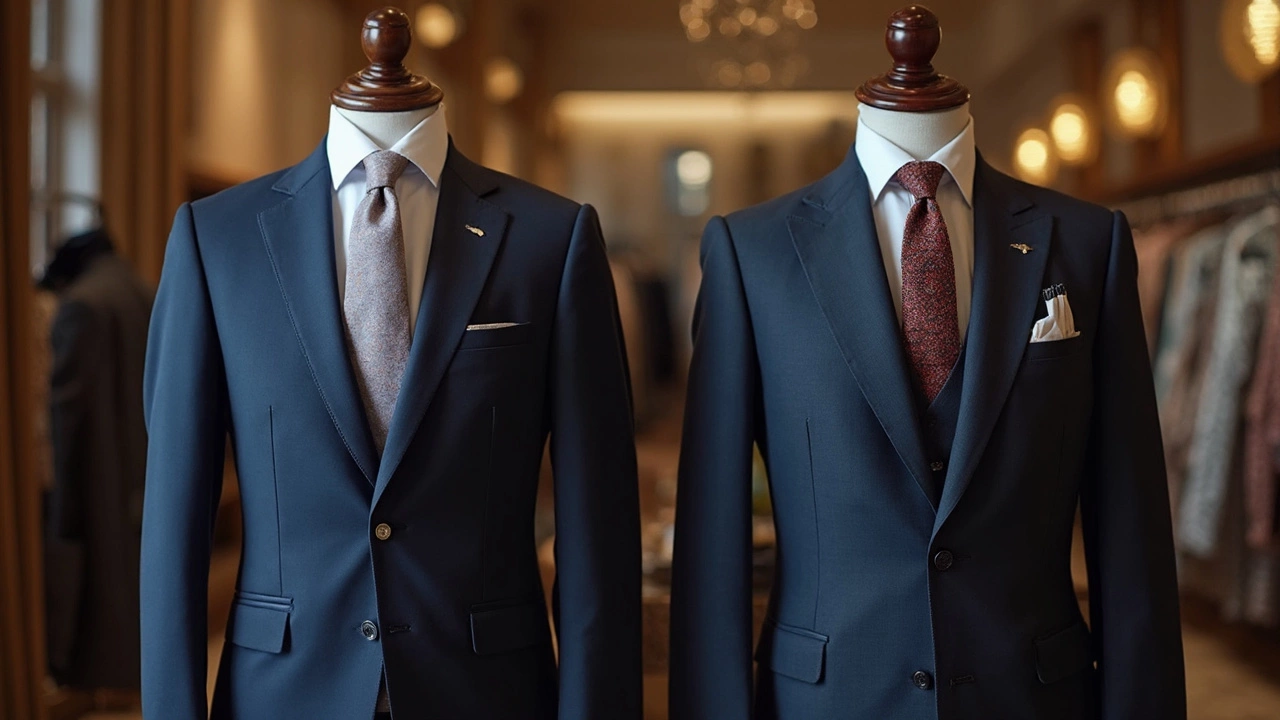Ever stopped in your tracks, staring at the price tag of a suit, and wondered, "Is this really worth it?" You're not alone! Suits can range from a humble $100 to a jaw-dropping $1000, and the difference isn't just a fancy label. Let's unravel what goes into these price tags.
First up, fabric. A $100 suit often features synthetic fibers like polyester, which keep costs down. These materials might look decent at first, but they can get uncomfortable really fast, especially if you're in them all day. On the flip side, a $1000 suit usually boasts wool, cashmere, or silk blends. These not only feel luxurious against the skin but breathe better, reducing sweat and keeping you cool. You can literally feel the quality – it's like the fabric is giving your skin a gentle hug.
Fabric Quality and Feel
The fabric is where the magic begins. If you've ever run your hands over a luxury suit, you've probably felt the difference immediately. But how does a $100 suit stack up against a $1000 one? Let's break it down.
Basic vs Luxury Fabrics
The budget suit might use materials like polyester or a polyester blend. It's not the worst, but it's known for trapping heat and not having much give, which can be a real bummer on hot days or long events. It's like wearing a stiff version of your favorite couch. You'll often notice a kind of shiny finish on these suits, which isn't exactly the sign of elegance.
On the flip side, a $1000 suit is usually made with natural fibers like wool, often from Australia or New Zealand. High-end suits might even have fabric from Italy or England, countries famed for their textile craftsmanship. Wool naturally adjusts to temperature changes and drapes beautifully on the body, adding to that sharp, tailored look.
Finding the Right Feel
If cashmere or silk are in the mix, you've got yourself a suit that feels like second skin. The nice thing about these materials is they don’t just look good—they breathe fantastically, too. Imagine having an all-day meeting but not feeling clammy. That's the real gift high-quality fabric offers.
You can even sometimes spot the quality difference with a simple touch: the finer fabrics feel almost buttery soft, which is why some people say you can sleep in them (although you probably shouldn’t).
Judging by the Weave
Within fabrics, there are different weaves to consider. A higher thread count often means a finer, softer material that resists wrinkles better. Ever heard of super 120s or super 150s wool? It's basically shorthand for smoothness and quality. Just don’t forget: the higher you go, the more careful you'll need to be with your suit. Drop a slice of pizza? It might not be so forgiving.
In the end, investing in a luxury suit isn’t just about showing off—it’s about embracing comfort and confidence. After all, when your suit feels right, you walk into a room like you own it!
Craftsmanship and Construction
Look under the hood of a suit, and you'll uncover a world of difference in the craftsmanship and construction between a budget $100 suit and its luxurious $1000 counterpart. Ever heard the phrase 'You get what you pay for'? It totally applies here.
Let's start with the stitching. On cheaper suits, you might find what's called 'fused' construction, where fabrics are glued instead of sewn. This is quick, easy, and less expensive, but it means the suit might lose its shape or bubble over time. In contrast, a $1000 suit often features a 'canvassed' construction, where a layer of canvas is stitched between the fabric and lining. This allows the suit to mold perfectly to your body over time, giving you that bespoke look.
Details Matter
Ever notice the buttons on a suit? Often, it's the little details that show the true level of craftsmanship. Budget suits might use plastic buttons which can break or look cheap. But premium suits go for natural materials like horn or mother-of-pearl, which last longer and add a touch of class.
Seams and Linings
The seams in a suit also reveal a lot. A stitch per inch (SPI) measure is commonly used to assess quality. Higher SPI means stronger and more durable seams. Spend more on a suit, and you'll likely find meticulous hand-sewn details, whereas cheaper suits might be entirely machine-stitched.
Then there's the lining. A $1000 suit might feature a lining made from Bemberg or silk, offering smoothness and breathability. Cheaper suits may resort to polyester linings, which aren't as breathable and can be uncomfortable during longer wear.
Attention to Fit
Finally, the construction affects how a suit fits. High-end suits often have careful attention to proportions and tailoring, resulting in a fit that's sleek and flattering. Lower-cost options may not offer the same level of fit finesse, often providing a more generic silhouette.

Fit and Comfort
When it comes to men's suits, nothing screams style more than a perfect fit. Whether you are spending $100 or splurging on a $1000 suit, how the suit fits can make or break your entire look. A cheaper suit often comes in generic sizes, which might fit some, but rarely offers that tailored charm.
The pricier suits usually provide the option for customization right from the get-go. Picture this: a suit designed to match every contour of your body. Sounds nice, right? Tailoring options for a $1000 suit might include choices for sleeve length, jacket taper, and even waist adjustments. This attention to fit ensures not only that you look sharp but also feel genuinely comfortable as you move, sit, or even dance!
Customization and Adjustments
In a $100 suit, alterations might still be possible but within certain limits. Cheaper suits often use fabrics that are more challenging to tailor effectively. On the other hand, high-quality fabrics found in more expensive suits offer greater flexibility for tailoring, allowing for precise alterations without compromising the fabric's integrity.
- The $100 suit might need frequent adjustments, especially after a dry-cleaning cycle, as cheaper materials can shrink or warp.
- Luxury suits maintain their shape and fit better over time, reducing the need for constant alterations.
Ultimately, when choosing between a $100 suit and a $1000 investment, consider how long you'll be wearing it and how much movement your day involves. Comfort often comes from how well it fits – something a high-quality suit is likely to nail.
Style and Brand Influence
When it comes to men's suits, the influence of style and brand can't be overstated. In the fashion world, especially in men's suits, brand names hold significant weight. Think of luxury brands like Tom Ford, Armani, and Zegna. Part of what you're paying for is the name, but it doesn't stop there. These brands invest heavily in innovative designs and top-notch materials that set trends rather than follow them.
Consider the iconic Gucci suit. You're not just buying clothes; you're buying into an image of sophistication and class. These suits often showcase unique cuts and patterns that you simply won't find in lower-priced ones. They’re tailored with precision to highlight modern aesthetics while maintaining timeless elegance.
Why Brands Matter
A well-known brand also means a commitment to quality. With a $100 suit, you're likely getting something mass-produced, with patterns that won't stray far from the basics. That doesn't cater to those who crave individuality or a fashion-forward look. On the other hand, a $1000 suit from a recognized brand often embodies meticulous attention to detail, ensuring you stand out.
Brand influence is stronger than you might think, often impacting decisions in a big way. We all know how hard it is to resist the allure of a luxe logo, right? But beyond that initial attraction, investing in a high-end suit brand often means better resale value and durability, essentially making it a long-term wardrobe staple.
Does Higher Price Mean Better Style?
You might be asking, "Does spending more always guarantee better style?" It's a valid question! High price tags often come with cutting-edge fashion elements, premium materials, and personalized tailoring. However, style is subjective. If you find that $100 suit truly speaks to your personal flair, and fits like a dream after some minor adjustments, then hey, you might have scored a winner! Still, a pricier suit typically offers thicker fabric, sharper cuts, and finer detailing that catches the eye, defining it beyond just fabric and thread.
In summary, when weighing a $1000 suit against a $100 one, consider what's most important to you. Is it the brand prestige, the unique style, or the tradition and craftsmanship that comes with the higher price? Either way, figuring out where style and brand fit into your suit-buying priorities will save you not just money, but possibly a lot of fashion faux pas down the road.

